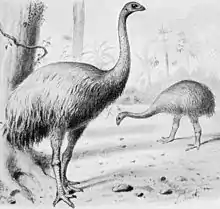Alice Mackenzie (author)
Alice Mackenzie (née McKenzie) (1873–1963)[1] was a 19th-century New Zealand author, settler and poet known for her book The Pioneers of Martins Bay describing her early life at Martins Bay, New Zealand in the 1870s and 1880s and supposed sighting of the extinct flightless bird the Moa.
Alice Mackenzie | |
|---|---|
 | |
| Born | 1873 |
| Died | 1963 (aged 89–90) |
| Nationality | New Zealand |
| Occupation | Writer |
| Known for | Author of The Pioneers of Martins Bay |
The Pioneers of Martins Bay
The Pioneers of Martins Bay is a historical book by Mackenzie, describing her early life at Martins Bay in the 1870s and 1880s.[2]
As a child, McKenzie and her family moved from Hokitika to Jackson Bay in Westland. After that they moved to Jamestown on Lake McKerrow. The township of Jamestown flopped and the McKenzies drifted down to Martins Bay. The hardships and isolation that followed the move are innumerable. Alice grew up in these isolated and lonely conditions and grew up to write the book.
The book was first published in 1947 by the Southland Historical Committee, and a revised edition was self-published in 1952.[3]
Moa sighting

McKenzie grew up in what was then New Zealand's most remote settlement Martins Bay, then part of Otago, but now part of Fiordland National Park. In 1880, as an eight-year-old, Alice had a meeting with a large bird that she believed had been a takahe for many years. But when that bird was suddenly rediscovered in the 1940s, and Alice saw what it looked like, she knew that she had seen something else. She was interviewed by the New Zealand Broadcasting Service in 1959 and talked to many scientists and later that year examined the feet of a takahe and moa to see the look at both together. Then after years of research they approved that what she saw was a baby moa about 3 years of age due to the size of the foot print and are if that moa is still healthy it could still me alive as they can survive to for about 180 years [4]
"It was lying on the sand, sunning itself.
"I got nearer and nearer until I sat down on the sand behind it. I remember stroking its back. It had no tail.
"It just lay there, it was quite quiet. So I put my hand underneath it and drew out one of its legs. It took no notice of me. I started to tie the flax around it, I thought I'd tie it up.
"Then it got up and made a harsh, grunting cry and bit at me. And I ran as hard as I could over the sandhills towards the sea. I thought if I went down to the sea it mightn't follow me into the water. I never looked behind, it never came very far with me.
"When I got home and told my father he came to have a look. But the bird was gone when he came. He saw its tracks where it had followed me from the top of the sandhills but it didn't go over them.
"He had a foot-rule in his pocket and he measured the tracks. From the heel to the middle toe was 11 inches."[5]
In Connected 2013 level 2 - I Spy... an article called What Alice Saw by Don Long and illustrated by Adele Jackson looked at Mackenzie's Moa sighting.[6]
Bibliography
- The Pioneers of Martins Bay
- Poems
References
- "NLA". VIAF. Retrieved 12 November 2019.
- "Tale of early Otago". Lake County Mail (22). 22 October 1947. p. 5. Retrieved 2 November 2019.
- Hall-Jones, John. Martins Bay. Craig Printing Co. Ltd., Invercargill, New Zealand, 1987.
- "Moa sightings: From the incredible to the... Credible?". 20 June 2018.
- "Alice Mackenzie describes seeing a moa and talks about her book, Pioneers of Martins Bay".
- https://instructionalseries.tki.org.nz/Instructional-Series/Connected/Connected-2013-level-2-I-Spy/What-Alice-Saw